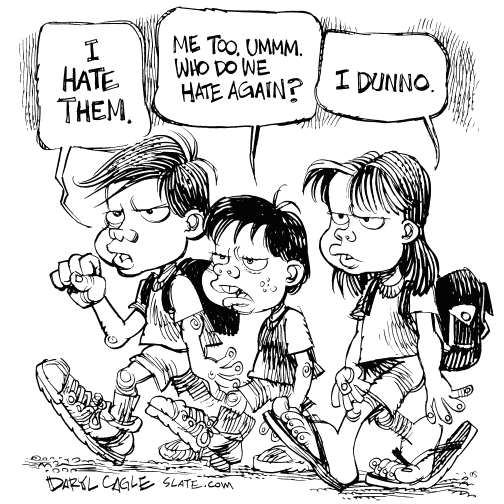At the end of the lesson, students will be able to:
- understand the use of dialogue in editorial cartoons
- question why one group might blindly hate another group
- How are editorial cartoons different from other kinds of art and media?
- How can images and text work together to deliver a message?
Enduring Understandings
- Editorial cartoons use line drawings and sometimes words to express their opinions or those of their media outlet about events in the news.
- Editorial cartoonists often use both pictures and text to convey their message. The text can help drive home a message or play off the images in the cartoon.
Copies of the editorial cartoon (below).
Suggested Procedure
Share with students that dialogue, or the words spoken between people or characters, is sometimes used in editorial cartoons in the form of text in speech bubbles. Dialogue in editorial cartoons often uses the kind of language that the people would actually use. For example, if the subjects being portrayed are children, the dialogue might include slang. If the characters have accents, the text might reflect that. Dialogue is one way to capture a person’s true voice—as well as his or her strong feelings and point of view.
Make copies of or project the cartoon below.

Artist: Daryl Cagle. Reprinted with Permission. Teachers may purchase individual cartoons for other lesson plans at PoliticalCartoons.com
1. Ask the class to discuss the following questions:
- How would you describe the dialogue in this cartoon?
- What does the dialogue suggest about the artist’s message? How so?
2. Divide students into pairs or small groups. Ask the groups to examine the following questions:
- What are the different ways the word hate can be used? Ask students to keep in mind that a person can hate vegetables, but he or she can also hate an entire group of people. How are these two forms of hate different? Ask a representative from each group to share the group’s responses with the class.
3. As a class, discuss the concept of hating another group of people:
- What happens when one group of people hates another group of people?
- In the cartoon above, two out of the three characters don’t even remember which group it is that they hate.
- Do you think people might forget why they hate a whole group of people? How so?
- What is the effect of this kind hatred on society?
- What does the dialogue tell you about the characters in this cartoon?
- Whom do you think these characters hate? Explain your answer.
Extension Activity
Tell group members to work together to create a cartoon that points out the dangers of hating an entire group of people. Tell students to use carefully crafted dialogue to convey a powerful message. Ask the groups to discuss their cartoons with the class. Have students submit their cartoons to a school or community newspaper/website.
Alignment to Common Core State Standards: CCSS R.2, R.4, R.6, R.7, R.10, SL.1, SL.2, SL.5